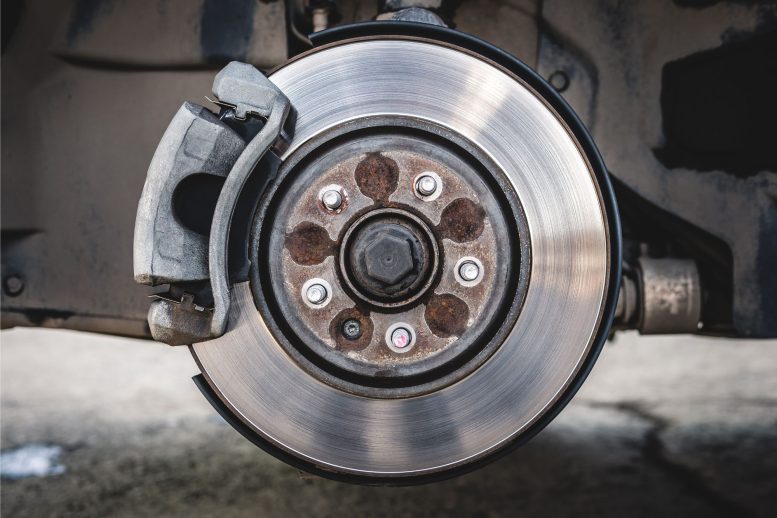
A study from the University of California, Irvine reveals that most particles released when vehicles brake are electrically charged, offering a potential method to reduce air pollution using electrostatic precipitators. Highlighting the health and environmental justice issues of non-exhaust emissions, the findings stress the importance of addressing brake emissions, especially in lower-income, traffic-heavy areas.
The work may aid in controlling an important source of air pollution.
Researchers have a limited understanding of the particles emitted into the air when a vehicle’s brakes are applied. However, there are indications that these particles could pose a greater health risk than the emissions from the tailpipe.
In a new study in Proceedings of the National Academy of Sciences, University of California, Irvine researchers show how most of these particles emitted during light braking carry an electric charge – something that could potentially be exploited to help reduce air pollution from vehicles.
“We found that up to 80% of aerosol particles emitted from braking are electrically charged, and that many of them are in fact highly charged,” said Adam Thomas, a doctoral candidate in the lab of Jim Smith, professor of chemistry, who led the study alongside UCI postdoctoral researcher Paulus Bauer.
To do the work, the team used a large lathe to spin a detached brake rotor and caliper. They then measured the electric charge of the aerosols emitted into the air and discovered the 80 percent figure.
“I was very surprised,” said Smith. “We were also surprised that this has not really been studied given how common cars are in human societies.”
Implications for Public Health and Environment
The research is part of a broader team effort at UCI to understand the public health impacts of non-tailpipe emissions in areas beset by car traffic, including many areas in Southern California.
“The toxicity and health effects of brake wear particles are largely unknown,” said Manabu Shiraiwa, professor of aerosol chemistry at UCI and one of the researchers behind the university-wide project. “Recent results from my lab indicate that they may induce oxidative stress, but more research is needed.”
The new study reveals a problem that may grow as electric cars become more and more common over the next several decades. Electric cars, Smith explained, are not truly zero-emission vehicles, so municipalities need to think about strategies to reduce emissions from brake use as well as tailpipes.
Addressing Brake Emissions
The team found that the percentage of charged particles emitted largely depended on the material makeup of brake pads. Because the particles carry an electric charge, this should make it relatively easy to remove from the air.
“If they are charged, they can be removed easily from the air before they have a chance to have an impact at all on health,” said Smith. “All you would need to do is to collect them with an electrostatic precipitator – a device that exposes the charged particles to an electric field and efficiently sweeps them away.”
The public health risk posed by brake emissions is not borne equally by a population – lower-income parts of cities tend to be more traffic-heavy than others, which creates an environmental justice issue wherein certain socioeconomic classes are more exposed to brake emissions than others.
According to Professor Barbara Finlayson-Pitts, Distinguished Emeritus Professor of chemistry and the principal investigator of the project at UCI, emissions from braking are not well-characterized but are potentially significant in high-traffic areas. “These areas are often in poorer communities and highlight an important aspect of environmental justice that has been largely overlooked,” Finlayson-Pitts said.
Reference: “Automotive braking is a source of highly charged aerosol particles” by Adam E. Thomas, Paulus S. Bauer, Michelia Dam, Véronique Perraud, Lisa M. Wingen and James N. Smith, 11 March 2024, Proceedings of the National Academy of Sciences.
DOI: 10.1073/pnas.2313897121
The UCI team is working with local community organizations like the Madison Park Neighborhood Association in Santa Ana, which is helping disseminate UCI’s scientific findings to the public. Funding for the study came from fees paid by Volkswagen as part of a 2016 settlement reached with the California Department of Justice, which found that the company used devices that contributed to increased air pollution.









Brake dust is not more harmful than exhaust. Try sitting in a closed garage with a car wheel braking. Don’t try sitting in a closed garage with a car exhausting fumes.
Brake dust is highly charged, obviously. Have the study authors really never tried to wash a car? It doesn’t chemically adhere to the wheel, but wheels are efficient precipitators already.
“The public health risk posed by brake emissions is not borne equally by a population …”
It has not been established that there is a public health risk. It is an assumption that is not supported by their earlier statement, “The toxicity and health effects of brake wear particles are largely unknown.”
In the doses to which we are typically exposed, neither brake dust nor exhaust are immediately fatal. The concern is that brake dust has the potential to be more damaging in long term exposure. The materials in brake pads are chosen for heat resistance but not studied for their effect on lung tissue. In the past asbestos was a component of brake pads. When you show that they are charged that means that they may travel further or may be more likely to adhere to tissues. Seems like a reason to study the effects.
I try not to use brakes. They just slow you down…
Electric cars have regenerative braking
“The new study reveals a problem that may grow as electric cars become more and more common over the next several decades. Electric cars, Smith explained, are not truly zero-emission vehicles, so municipalities need to think about strategies to reduce emissions from brake use as well as tailpipes”
This bears greater explanation. Electric vehicles all utilise regenerative braking, which merely turns the motor into a generator and harvests the resistance for light braking events. Brake pads are only used for emergencies. This even causes brake calipers to rust prematurely from lack of use. This is purely an internal combustion engine problem.
“This even causes brake calipers to rust prematurely from lack of use.”
Do the brake pads not touch the surface of the calipers as with ICE vehicles? If that is the case, then there is a potential for sand or larger particles to get between the pads and calipers and cause a malfunction in an emergency application.
No, the normal brakes are the same design in EVs and ICEs. So your comment, as I suspect you know, is misleading.
Brakes, clutches, tires, even shoe soles all create microscopic particles of the surface material. Even wind driven dirt particles create more particles by impact with other sand and dirt particles. Human activities on this planet are relatively insignificant compared to natural events. Adding electrostatic precipitators to every friction causing device would be impractical to say the least.
Electrostatic precipitators only collect charged particles. The particles must to be cleaned and disposed of somehow.
Electrodynamic braking is a possible method of reducing friction braking and wear as well. New permanent magnet materials have improved to the point that magnetic flux may be strong enough to make magnetic retarders practical. Engine compression braking is also possible with spark ignited engines with minor modifications to valve timing and fuel injection controls.
I can totally believe this the fumes and smoke from the pads being excessively heated the smell alone can turn your stomach.